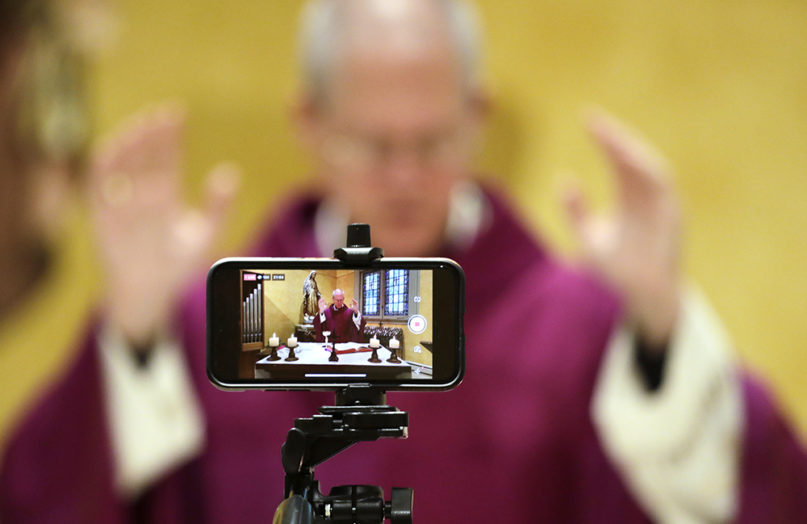(RNS) — When the COVID-19 pandemic led governors across the United States to close places where people congregated, religious organizations were left scrambling. While some larger houses of worship had already been broadcasting their weekend services online, many had to suddenly and urgently master the logistics of streaming worship online.
The vast majority adapted quickly. In 2020, Lifeway, the Southern Baptist Convention’s research arm, indicated that just a few months into the pandemic, 97% of churches were offering some form of online worship, salvaging the best form of connection to their congregants they had.
Today, as a result, many religious leaders are facing a difficult transition: How do they nudge people off of streaming and back into the pews for weekend worship? And will they ever pull the plug on streaming services altogether?
Data from the Pew Research Center just uploaded to the Association of Religion Data Archives provides interesting insights into how religious Americans expected online services to reshape their religious lives. The American Trends Panel Wave 70 was conducted in July of 2020 — still early days of the pandemic, so it represents only worshippers’ intentions. But the survey provides some of the most wide-ranging and revealing numbers we have seen on attendance before and after the pandemic.
To begin with, it’s crucial to note that 43% of respondents, when asked about their possible religious attendance after the pandemic was over, indicated, “I did not attend religious services in person before the outbreak and will not attend when the outbreak is over.”
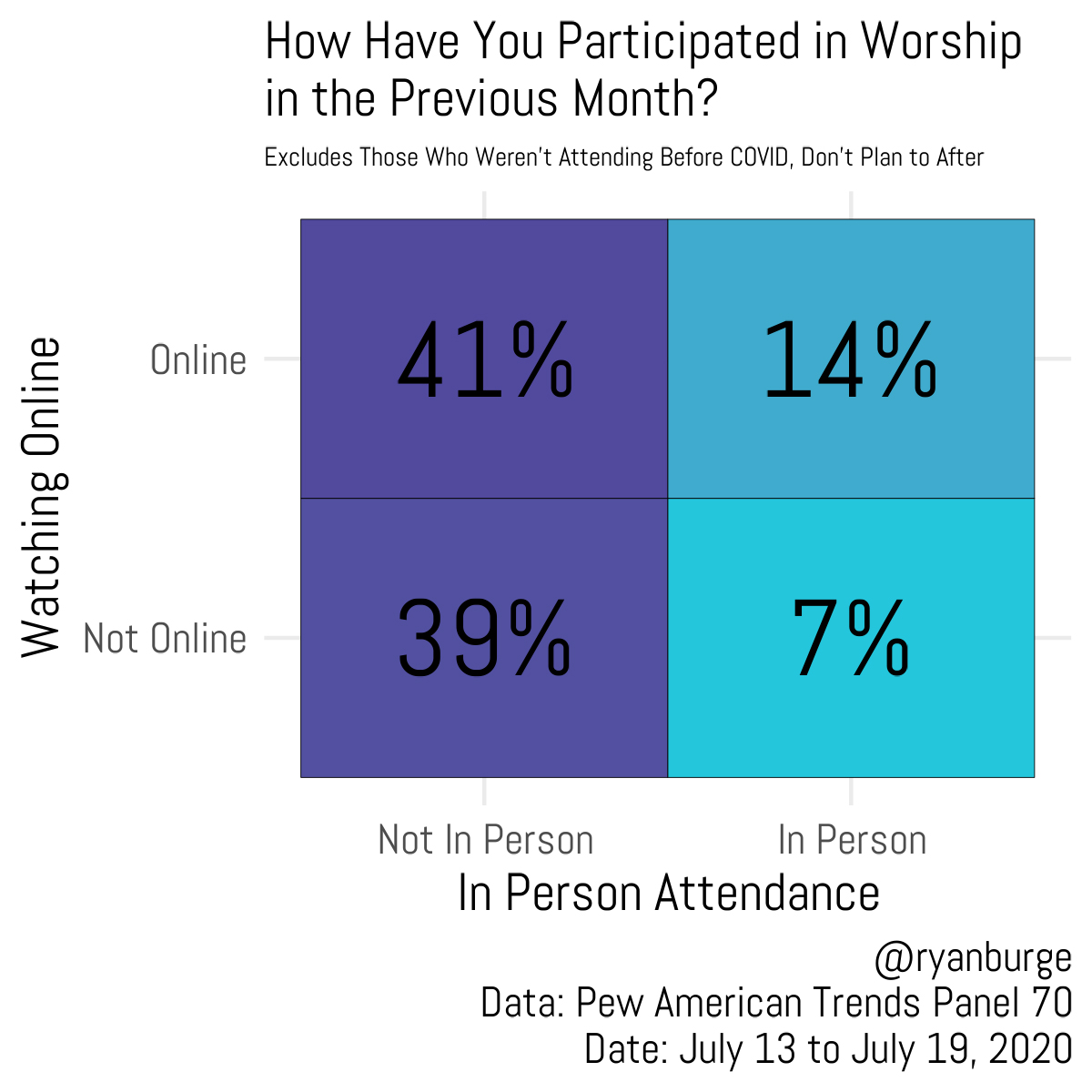
“How Have You Participated in Worship in the Previous Month?” Graphic courtesy of Ryan Burge
Thus, 2 in 5 Americans said COVID-19 had no effect on their attendance at a religious institution at all. The rest of the analysis included only those who said they would attend services online or in person after the pandemic was over.
In July of 2020, 41% of those surveyed responded that they were attending religious services exclusively online; another 14% said they were participating in worship both online and in person. Seven percent said that they were exclusively attending in person.
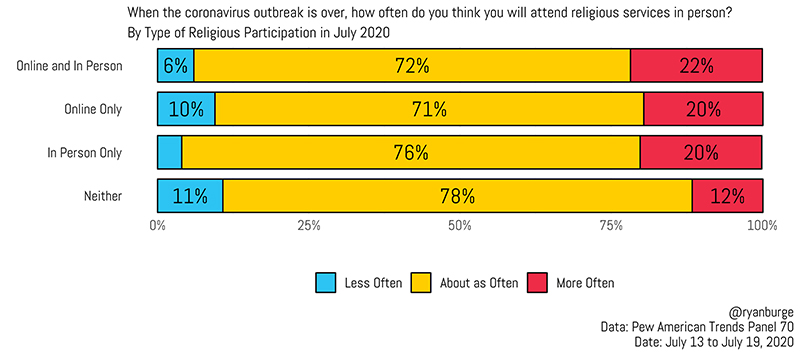
“When the coronavirus outbreak is over, how often do you think you will attend religious services in person? By Type of Religious Participation in July 2020” Graphic courtesy of Ryan Burge
The real surprise of the Pew numbers is the 39% who planned to attend religious services in person or online after the lockdowns ended who said that they were not attending either option in July 2020. They had simply withdrawn from worshipping altogether.
One concern that religious leaders have had is that some of their congregation would find online streaming more convenient and would not return to worship in person when the lockdowns were lifted. The data provides some comfort on that question.
Among those who were exclusively streaming services in July of 2020, only 10% said they planned to attend services less often after restrictions were lifted. That’s not materially different from those who said they were not attending services at all during lockdowns. In other words, their behavior during the lockdowns didn’t seem to influence how frequently they intended to come to church, synagogue, mosque or temple after the pandemic.
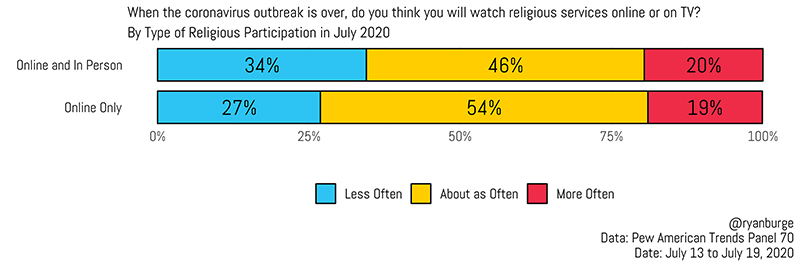
“When the coronavirus outbreak is over, fo you think you will watch religious services online or on TV? By Type of Religious Participation in July 2020” Graphic courtesy of Ryan Burge
But what about using streaming to attend religious services after the lockdowns have ended? Among those who reported that they were both attending services in person and watching them online in July 2020, 34% said they would stream services less often once the lockdown had ended. Among those who were streaming exclusively in July of 2020, 27% said that they would be watching online less often when the COVID-19 restrictions had been lifted.
It seems clear from these figures that most people saw the online experience as a stop-gap measure, not a paradigm shift in how they connect with a religious community.
Nor does the quality of the online experience seem to have an effect on their return to the pews. Pew asked respondents how satisfied they were with watching a religious service through the internet. Satisfaction was high: 54% said “very satisfied,” 37% said “somewhat satisfied” and just 8% said they were not at all or not too satisfied with their online experience.
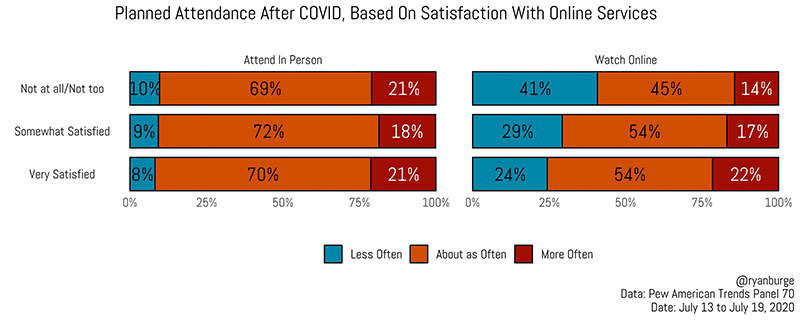
“Planned Attendance After COVID, Based On Satisfaction With Online Services” Graphic courtesy of Ryan Burge
Across this range, about 90% of people said that they planned to attend in person about as often or more often when they were allowed to return to corporate worship.
Not surprisingly, having an unsatisfactory experience online did convince some people to expect they would be less likely to stream services after lockdowns were over. Of those who reported low satisfaction, 41% said that they would be watching services less often when they could return in person. Even among those who had a good experience watching online services, a quarter said that they would use the online option less often when COVID-19 was over.
When looked at broadly, there is cause for concern and comfort in this data. It should be troubling for religious leaders that about 40% of people who were worshipping in person before COVID-19 were not attending worship services in July of 2020 (either in person or through the internet). They can take comfort, however, that no matter how an individual was connected to their local congregation (either online, in person or not at all), there is little difference in their desire to return to worship.
It’s important to remember that these questions were asked about future behavior. More recent surveys have indicated that religious attendance has dropped substantially from 2018 and 2022. Next, we have to better understand any disconnect between how people thought they were going to behave and how they actually participated in religious communities after the lockdowns ended.

Ryan Burge. Courtesy photo
(Ryan Burge is an assistant professor of political science at Eastern Illinois University, a pastor in the American Baptist Church and author of “The Nones: Where They Came From, Who They Are, and Where They Are Going.” He can be reached on Twitter at @ryanburge. The views expressed in this commentary do not necessarily reflect those of Religion News Service.)
Ahead of the Trend is a collaborative effort between Religion News Service and the Association of Religion Data Archives made possible through the support of the John Templeton Foundation. See other Ahead of the Trend articles here.
